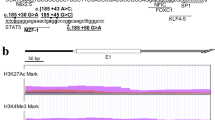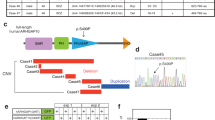Abstract
Tyrosine hydroxylase (TH) is the rate-limiting enzyme in dopamine (DA) biosynthesis.1,2 Exon 3 of the human TH gene encodes the sequence from Ser31 to Glu104 of type 1 enzyme,3,4 which contains the critical parts for regulation of the catalytic activity. The amino acid residues Gly36-Arg37-Arg38 were identified as a key sequence for DA to exert its inhibitory effect on catalytic activity.5–7 Therefore, we screened the nucleotide sequences of exon 3 from 201 Japanese patients with schizophrenia to explain the elevation in the synaptic or presynaptic DA concentrations in the schizophrenic brain,8–11 based on the hypothesis that any mutation changing the amino acid sequence Gly36-Arg37-Arg38 would result in the elevation of DA synthesis, due to a reduced inhibitory effect of DA on the catalytic activity.5–7 However, no mutated sequences of exon 3 and both exon–intron boundaries were detected in any of the patients examined. Polymorphisms generating Val81 and Met81 were compared of the distributions of genotype and allele between the patients and 175 Japanese healthy controls, which did not suggest an association between the polymorphism and schizophrenia. These results indicate that exon 3 of the human TH gene lacks association with schizophrenia in Japanese patients.
This is a preview of subscription content, access via your institution
Access options
Subscribe to this journal
Receive 12 print issues and online access
$259.00 per year
only $21.58 per issue
Buy this article
- Purchase on Springer Link
- Instant access to full article PDF
Prices may be subject to local taxes which are calculated during checkout

Similar content being viewed by others
References
Nagatsu T, Levitt M, Udenfriend S . Tyrosine hydroxylase. The initial step in norepinephrine biosynthesis J Biol Chem 1964 239: 2910–2917
Levitt M, Spector S, Sjoerdsma A, Udenfriend S . Elucidation of the rate-limiting step in norepinephrine biosynthesis in the perfused guinea pig heart J Pharmacol Exp Ther 1965 148: 1–8
Grima B, Lamouroux A, Boni C, Julien JF, Javoy-Agid F, Mallet J . A single human gene encoding multiple tyrosine hydroxylases with different predicted functional characteristics Nature 1987 326: 707–711
O'Malley KL, Anhalt MJ, Martin BM, Kelsoe JR, Winfield SL, Ginns EI . Isolation and characterization of the human tyrosine hydroxylase gene: identification of 5′ alternative splice sites responsible for multiple mRNAs Biochemistry 1987 26: 2910–2914
Ota A, Nakashima A, Mori K, Nagastsu T . Effects of dopamine on N-terminus-deleted human tyrosine hydroxylase type 1 expressed in Escherichia coli Neurosci Lett 1997 229: 57–60
Nakashima A, Mori K, Suzuki T, Kurita H, Otani M, Nagatsu T et al. Dopamine inhibition of human tyrosine hydroxylase type 1 is controlled by the specific portion in the N-terminus of the enzyme J Neurochem 1999 72: 2145–2153
Nakashima A, Hayashi N, Mori K, Kaneko YS, Nagatsu T, Ota A . Positive charge intrinsic to Arg37-Arg38 is critical for dopamine inhibition of the catalytic activity of human tyrosine hydroxylase type 1 FEBS Lett 2000 465: 59–63
Hietala J, Syvälahti E, Vuorio K, Räkköläinen V, Bergman J, Haaparanta M et al. Presynaptic dopamine function in striatum of neuroleptic-naive schizophrenic patients Lancet 1995 346: 1130–1131
Breier A, Su TP, Saunders R, Carson RE, Kolachana BS, de Bartolomeis A et al. Schizophrenia is associated with elevated amphetamine-induced synaptic dopamine concentrations: evidence from a novel positron emission tomography method Proc Natl Acad Sci U S A 1997 94: 2569–2574
Lindström LH, Gefvert O, Hagberg G, Lundberg T, Bergström M, Hartvig P et al. Increased dopamine synthesis rate in medial prefrontal cortex and striatum in schizophrenia indicated by L-(β-11C) DOPA and PET Biol Psychiatry 1999 46: 681–688
Laruelle M, Abi-Dargham A, Gil R, Kegeles L, Innis R . Increased dopamine transmission in schizophrenia: relationship to illness phases Biol Psychiatry 1999 46: 56–72
Lüdecke B, Bartholomé K . Frequent sequence variant in the human tyrosine hydroxylase gene Hum Genet 1995 95: 716
Haycock JW . Phosphorylation of tyrosine hydroxylase in situ at serine 8, 19, 31, and 40 J Biol Chem 1990 265: 11682–11691
Dumas S, Le Hir H, Bodeau-Pean S, Hirsch E, Thermes C, Mallet J . New species of human tyrosine hydroxylase mRNA are produced in variable amounts in adrenal medulla and are overexpressed in progressive supranuclear palsy J Neurochem 1996 67: 19–25
Ishiguro H, Arinami T, Saito T, Akazawa S, Enomoto M, Mitushio H et al. Systematic search for variations in the tyrosine hydroxylase gene and their associations with schizophrenia, affective disorders, and alcoholism Am J Med Genet 1998 81: 388–396
Ota A, Yoshida S, Nagatsu T . Deletion mutagenesis of human tyrosine hydroxylase type 1 regulatory domain Biochem Biophys Res Commun 1995 213: 1099–1106
Zhou QY, Quaife CJ, Palmiter RD . Targeted disruption of the tyrosine hydroxylase gene reveals that catecholamines are required for mouse fetal development Nature 1995 374: 640–643
Lüdecke B, Dworniczak B, Bartholomé K . A point mutation in the tyrosine hydroxylase gene associated with Segawa's syndrome Hum Genet 1995 95: 123–125
van den Heuvel LP, Luiten B, Smeitink JA, de Rijk-van Andel JF, Hyland K, Steenbergen-Spanjers GC et al. A common point mutation in the tyrosine hydroxylase gene in autosomal recessive L-DOPA-responsive dystonia in the Dutch population Hum Genet 1998 102: 644–646
Lüdecke B, Knappskog PM, Clayton PT, Surtees RA, Clelland JD, Heales SJ et al. Recessively inherited L-DOPA-responsive parkinsonism in infancy caused by a point mutation (L205P) in the tyrosine hydroxylase gene Hum Mol Genet 1996 5: 1023–1028
Bräutigam C, Steenberger-Spanjers GC, Hoffmann GF, Dionisi-Vici C, van den Heubel LP, Smeitink JA et al. Biochemical genetic characteristics of the severe form of tyrosine hydroxylase deficiency Clin Chem 1999 45: 2073–2078
Goodwill KE, Sabatier C, Marks C, Raag R, Fitzpatrick PF, Stevens RC . Crystal structure of tyrosine hydroxylase at 2.3 and its implications for inherited neurodegenerative diseases Nat Struct Biol 1997 4: 578–585
Polymeropoulos MH, Xiao H, Rath DS, Merril CR . Tetranucleotide repeat polymorphism at the human tyrosine hydroxylase gene (TH) Nucleic Acids Res 1991 19: 3753
Wei J, Ramchand CN, Hemmings GP . Association of polymorphic VNTR region in the first intron of the human TH gene with disturbances of the catecholamine pathway in schizophrenia Psychiatr Genet 1995 5: 83–88
Thibaut F, Ribeyre JM, Dourmap N, Meloni R, Laurent C, Campion D et al. Association of DNA polymorphism in the first intron of the tyrosine hydroxylase gene with disturbances of the catecholaminergic system in schizophrenia Schizophr Res 1997 23: 259–264
Kunugi H, Kawada Y, Hattori M, Ueki A, Otsuka M, Nanko S . Association study of structural mutations of the tyrosine hydroxylase gene with schizophrenia and Parkinson's disease Am J Med Genet 1998 81: 131–133
Hertel P, Fagerquist MV, Svensson TH . Enhanced cortical dopamine output and antipsychotic-like effects of raclopride by α2 adrenoceptor blockade Science 1999 286: 105–107
van Rossum JM . The significance of dopamine-receptor blockade for the mechanism of action of neuroleptic drugs Arch Int Pharmacodyn 1966 160: 492–494
Carlsson A . The current status of the dopamine hypothesis of schizophrenia Neuropsychopharmacology 1988 1: 179–186
Seeman P . Schizophrenia as a brain disease. The dopamine receptor story Arch Neurol 1993 50: 1093–1095
Acknowledgements
We would like to express our gratitude to all patients and control individuals for their participation in this study. We also thank to Dr Y Ono (Fujita Health University) for his critical reading of the manuscript. This study was supported by grants-in-aid from Fujita Health University, Japan, to A Ota.
Author information
Authors and Affiliations
Corresponding author
Rights and permissions
About this article
Cite this article
Ota, M., Nakashima, A., Ikemoto, K. et al. Exon 3 of tyrosine hydroxylase gene: lack of association with Japanese schizophrenic patients. Mol Psychiatry 6, 315–319 (2001). https://doi.org/10.1038/sj.mp.4000840
Received:
Revised:
Accepted:
Published:
Issue Date:
DOI: https://doi.org/10.1038/sj.mp.4000840



